By Eric and Chris Martinez
January 2013.
“Shows are won in the offseason. No amount of work ‘in-season’ can undo a lazy offseason.” -Layne Norton
During off-season dieting, we’re almost 100% certain that you have been down multiple avenues looking for the most efficient way to build muscle mass while trying to avoid excess fat gain. A lot of us have made mistakes, some of us have gotten results out of spite, not because what we did was optimal, some of us have just flat out tried everything and are still scratching our heads in confusion, and then there’s those who really don’t give a damn and just eat whatever the hell they want and will literally think they’re building pure muscle mass, but not realize they also have a huge Good Year tire around their waist. If you are really looking to gain muscle mass with minimal excess fat gains, then you really need to have a strategic plan for your off-season diet, plan on being patient, be consistent day in and day out with your nutrition program, and work your ass off in the gym. If any of these are lacking in your plan, no amount of work ‘in-season’ can undo a lazy offseason. With all that said, let’s get into how you can gain lean body mass without the Good Year tire.
Importance of slow bulking
When we say slow bulking, in other words we are saying be patient while in a caloric surplus. As we should all know, results do not happen overnight with anything and while in a caloric surplus it’s no different. It is also no different than when one is in a caloric deficit, you have to slowly take out calories from your macronutrient numbers each week if you do not lose weight. You want to preserve as much muscle as possible while doing that. Vice versa when in a caloric surplus you want to slowly add calories in from your macronutrient numbers each week while not putting on excess fat whilst gaining muscle mass. If you are not patient and tend to jump the gun and add in too many calories, well you’re setting yourself up to gain excessive adipose tissue.
Bulking Too Fast
Many of us want to put on muscle as fast as possible and fill out our shirts, and at times you hear the local guru utter, “just eat everything in sight bro and you will get big.” Not so fast there, yes you will go up in weight, but is it muscle mass? Most likely if you are just eating everything in sight you are going to put on a significant amount of body fat, unless you are genetically gifted or have an ectomorphic body type and can get away with it. The smartest approach when in a caloric surplus (bulking) is to gain 0.5-1.5 lbs a week. That way you know you are putting on mainly muscle mass and not excess fat. But, keep in mind that gaining 0.5 pounds of muscle per week consistently is not guaranteed. Eventually you will put on some fat throughout your off-season, but wouldn’t it be better to put the least amount of fat as possible? Especially if you have an endomorphic body type and tend to put on fat faster than the average Joe. With that said, play it safe and give yourself a larger time frame when in a caloric surplus; It’s a marathon, not a sprint.
Cyclical Bulking
“Dude you’re never gonna get jacked if you try to stay lean all year round. You have to eat everything in sight bro!”
Please tell us you’ve heard someone at your gym or local gurus say this? Typically the people that say this, are the ones that don’t care about putting on excess fat during the off-season and that’s completely fine, but we know that we and most of you like to look like body builders year round. With that said, adding a bunch of excess body fat will mean that you have to diet longer and harder to get rid of it come pre-contest, leading to more muscle loss during your diet, dealing with loose skin, and reversing whatever extra muscle you might have gained by eating like an offensive lineman.
Excess body fat can also have negative metabolic effects. Research is showing that adipose tissue (fat) is not just an inert storage tissue. Adipose secretes its own hormones and cytokines (called adipokines) which can have numerous metabolic effects. Several adipokines secreted from adipose like TNF-α can reduce insulin sensitivity in other tissues like muscle. Not only is this going to make it easier for body fat to accumulate but it may hamper your ability to benefit from the anabolic and anti-catabolic effects of insulin.
So it’s pretty safe to say that eating everything in sight type of approach isn’t the ideal strategy you want to use. Over the past years we have found Dr. Layne Norton’s cyclical bulking method to be very effective at increasing lean body mass while limiting fat gain. Essentially, cyclical bulking consists of anywhere from 4-8 months of bulking mixed with 6-18 week bouts of cutting. Now, please keep in mind that these are just general time frames and this will all depend on the individual. It all depends on how fast your body starts putting on excess fat during the bulk phase and how much excess adipose tissue you want to lose during the cut phase.
Now, you are probably reading this and saying why the hell would I even try that? By cycling your bulking and cutting protocols you can take advantage of various metabolic swings that occur in response to bulking and cutting and optimize your body’s response to each. When you first begin cutting after a bulk you are in a prime position to drop body fat as there are several factors working in your favor. Your metabolic rate is elevated from being in a caloric surplus as your levels of T3, leptin, and other hormones that deal with metabolic rate and fat oxidation are all elevated in response to a caloric surplus in order to deal with disposal of all the calories you’ve been eating. When you start dropping calories during a cut, you rapidly drop fat because all these factors are still elevated and are working in your favor. Your metabolic rate is through the roof and burning calories like no other! But, after a few months the body will begin adapting to the reduction in calories by reducing T3, leptin and other factors which will in turn cause the metabolic rate to plummet. Also, fat loss grinds to a halt and that’s usually a good indication that it’s time to start bulking again.
Keeping Your Body Anabolic Overnight
New research by Van Loon et al. has proven that overnight protein administration stimulates muscle protein synthesis. There were two studies done, the first being in elderly men and the second being done in recreationally active young males and they both showed that protein ingestion prior to sleep stimulated muscle protein synthesis overnight.
As it has been shown time and time again that 20-30g of protein (~10-15g EAA) is enough to fully max out MPS. Paddon-Jones et al. compared 30g of high quality protein to 90g of the same source and showed that 90g had no further benefit over the 30g dose. So the point being that you wouldn’t need more than 20-30g of a high quality protein before bed to maximally stimulate muscle protein synthesis. But, again not so black and white, this 20-30g dosage will also depend on the size of the individual and their overall total daily macros.
Even though there are basically only two studies for this, it shows that protein ingested immediately prior to sleep or during sleep is effectively digested and absorbed, therefore stimulating muscle protein synthesis overnight. It’s very fascinating and promising research so we highly recommend some sort of high quality protein source before bed or during the middle of the night. Yes! During the middle of the night, you do go to the bathroom don’t you? Just think about it, your body will be entering a 6-9 hour fast and why not have a steady stream of amino acids flowing in the bloodstream overnight and keeping anabolism elevated. Another suggestion we advocate is for those that have their calories at very high levels during bulking and are having trouble consuming all of their macros through their meals during the day, you can simply have a shake in the middle of the night that contains protein, carbs, and fats and this will be an easy way to ingest some of your daily calories.
Diet Information
The diet that one follows for their off-season will play a huge role in determining their muscle mass gains. A person can lift 7 days a week and have the sexiest training protocol but if they don’t have a proper nutrition plan to follow then they’re not going to fully maximize the potential results they can attain. To design a proper nutrition protocol you should give yourself adequate time to slowly gain the necessary muscle mass to achieve that aforementioned lean muscular look. If you’re not realistic with the adequate time you’re giving yourself you are likely going to put on more fat than muscle.
So what kind of nutrition plan should you follow you’re asking?
The Nutrition Protocol Should Have Three Main Goals:
-Slowly and deliberately adding in calories to avoid excess fat gain
-Gain as much muscle mass as possible without the compensation of excess fat gain
-Capitalize on meal frequency and nutrient timing
When the body is in a caloric surplus (bulking state), it is very easy to put on body fat although a calorie surplus is needed to gain muscle mass. When in a calorie surplus, it needs to be controlled through adding calories each week slowly (slow bulking) to avoid extra fat accumulation. Also, spacing your meals correctly and timing your meals correctly are imperative to your success in gaining muscle mass.
Before getting into more details about the proper nutrition program, it’s important to discuss the three macronutrients and their roles.
Protein
Protein will be a very dynamic macronutrient in your diet, it’s so powerful that when consumed, it will activate muscle protein synthesis (percentage of muscle tissue protein renewed each day) from leucine content. The majority of energy used to provide ATP for muscle protein turnover comes from the oxidation of fat, as this is the preferred energy substrate of muscle at rest. Therefore, a focus on maximizing the muscle synthetic response with ~10g of EAA may decrease a person’s body fat by increasing their resting energy expenditure from the increased lean mass.
Maximizing Muscle Protein Synthesis
The best way to get elevated levels of MPS is through the essential amino acid (EAA) “Leucine.” You can only get EAA’s through diet or supplementation, your body does not produce these amino acids. There have been countless studies showing that leucine is the key stimulator for MPS. You’re better off eating animal sources of protein because of the high leucine content. But, before you go buy a bucket of leucine powder and sprinkle it on your meats, please keep in mind that leucine is just a small piece of the puzzle, if you don’t have the other essential amino acids you will not build a protein. Leucine is actually a strong indicator of the quality of the protein you’re consuming as it relates to its ability to raise muscle anabolism. When you raise muscle anabolism, your body is in a great position to induce muscle tissue. The more muscle tissue one has, the higher their metabolic rate is going to be and this will keep fat to a minimum. Take home, aim for protein sources high in leucine to build muscle mass which we will discuss in the latter part of this article.
Protein distribution
The way you will distribute protein throughout the day will play a key role to enhancing muscle mass. A study done by Norton et al. Shows that an even distribution of protein (30g per meal at breakfast, lunch, and dinner) caused greater muscle gains over an 11-week period than the same total amount of protein distributed unevenly (10g at breakfast, 20g at lunch, and 60g at dinner). The conclusion showed that protein distribution is a critical factor in determining the efficiency of protein use for muscle anabolism. So, when you set up your protein distribution throughout the day we highly suggest keeping protein feedings consistent throughout each meal. An example would look like 200g protein a day through 4 meals is 50g at each meal.
Carbohydrates
The main purpose of carbohydrates is to provide energy and fuel for the body. Some people are very “carb happy,” meaning they can burn through carbohydrates and not gain a pound of fat and then there’s those that are “carb sensitive,” meaning there body has a hard time burning carbs and thus leading to fat storage. Carbs are very important for providing the body with energy and essential for gaining muscle mass.
Carbohydrates have probably gotten the worst reputation of the macronutrients due to eating excessive amounts leads to excess adipose tissue. Some of this is true, but when in a caloric surplus we feel that carbohydrates need to be as high as possible without excess fat gain and insulin sensitivity needs to be taken advantage of at the right times. Carbs are going to be very variable depending upon total calorie intake and insulin sensitivity. Some individuals will be able to tolerate carbs better than others, so it really depends on how healthy your metabolism is. If you damage your metabolism severely then it doesn’t matter about your body type.
The Importance of Taking advantage of insulin sensitivity
Insulin sensitivity refers to how much insulin it takes to clear a certain amount of glucose (carbs). During a caloric surplus, it’s imperative that you take advantage of insulin sensitivity in the a.m at breakfast, pre workout and post workout. These are the times that your body is most insulin sensitive and can best tolerate carbs. For example, we recommend breakfast because the majority of the population goes through a 6-8 hour fast during their sleep, so their bodies are desperately craving nutrients in the a.m. Pre and post workout; your body can best assimilate a high amount of carbs into your muscle tissues because your body is most insulin sensitive at these times. What does the increased insulin do you ask? Well, increased insulin will serve to shuttle all of the nutrients required by the body while also stimulating the release of insulin growth factors because your muscle cells are volatized and need nutrients to repair. Also, when you are working out, you cause an acute catabolic situation and your muscle does not become anabolic again until you consume sufficient nutrients. You also get an increase in insulin sensitivity by working out so you can more effectively tolerate and utilize carbohydrates post workout so it also makes sense to put more carbs post workout as compared to other times of the day. Take home, partition the majority of your daily carbs at breakfast and at pre and post workout to utilize insulin sensitivity best.
Fats
Fats are the most energy-dense macronutrient (9 kcals/gram) and they provide many of the body’s tissues and organs with most of their energy. Fat is the most critical macronutrient to optimize hormonal functions (i.e., testosterone, libido, etc). Fats are also essential for building muscle, reducing cortisol levels, providing energy, helps with hunger pangs, and assisting the body in functioning properly. The main hormone that we are interested in elevating through fat consumption is testosterone. It is vital that you aren’t deficient in dietary fat or it will impair hormone production.
Fat Intake and Testosterone
Since fat is responsible for optimizing hormonal functions, such as testosterone, this doesn’t mean to go down to Costco or Sam’s and purchase a tub of Crisco and go to town on it every day. Remember that fats are the most energy dense macronutrient (9 kcals/gram) and they can be easily stored as adipose tissue (body fat). So you must be aware of what your body metabolizes better through carbohydrates or fats because it will be up to you to play the trial and error game.
Several studies concluded that diets low in fat (under 15% of total calories) significantly decreased testosterone levels while diets higher in fat (above 30% of total calories) increased serum testosterone levels. To make things easier for you, it seems that one should not lower fat below 15% of daily calories unless they would like to see their testosterone levels plummet. On the contrary, you should not increase fat to over 40% in order to increase testosterone. But again, this is just a rough estimation and you have to try things out for your body. You might be able to go over 40% and make solid gains or you might start adding fat. Although fat increases testosterone to a degree, it is important to remember that testosterone is only a small piece of the larger pie. There are many other hormones and factors involved in building muscle other than just testosterone. By increasing fat to extremely high levels, there will be less “space” for carbohydrates and protein, both of which are very important for building muscle mass. Just be sure not to look at consuming fat in a linear fashion, as moderation is the key to everything in life.
Fiber
Fiber is a complex carbohydrate made up of non-starch polysaccharides, resistant starches, and cellulose. Fiber tends to sit longer in your GI (Gastrointestinal) which pulls fluids into the area. That’s normally a good thing because it makes you feel fuller. A carbohydrate with less fiber will be digested more rapidly and not pull water in your GI like something heavier would with a lot of fiber. Fiber also helps with: The importance for gut health and digestive health, it increases thermogenesis and thus helps with fat loss and it produces short chain fatty acids through fermentation in the colon and these have several beneficial metabolic effects.
How Much Fiber
So how much fiber should one consume a day? With fiber being such an important part of the diet, ISSN (International Society of Sports Nutrition) suggests a minimum of 25g per day for women and 38g per day for men. But, it’s not so simple to just say “Okay, so if ISSN recommends this amount, then that’s all I need to get for the day right?” Things are never black and white when it comes to nutrition and metabolism, there’s always a grey scale. So, our point being about daily fiber intake depends on a lot of factors. For example, the greater amount of fat you want to lose and the slower your metabolism is the more fiber should be raised as it has a thermogenic effect. And obviously a bigger person will need more fiber than a smaller person. So, again, there is no set calculation, but the ISSN recommendations are a good starting point.
Can you consume as much fiber as you want?
Not so fast, by consuming too much fiber it potentially reduces absorption of vitamins and minerals, diarrhea, cramping, and bloating. If you are fairly new to having fiber in your diet than you will tend to get fairly bloated because your digestive tract is not used to the high fiber content (cramps, bloating, and a lot of pooping could be symptoms). Eventually your body will adapt to it, so don’t panic.
Nutrient Timing
Nutrient timing is a crucial aspect during a caloric surplus. Every calorie counts each and every day and nutrient timing takes consistency. One must consistently spread their macronutrients out and get a good balance of them in each meal or as we said earlier, hit your daily numbers as accurate as possible. Pre and post workout meals are going to be your money makers. While in a caloric surplus it’s best to get the majority of your daily carbs around your pre and post workout meals. Why? You want more carbs for energy during an intense training bout, also carbs are protein and muscle sparing during exercise and because they are a cause of insulin release. We all know insulin happens to be one of the most anabolic and anti-catabolic hormones in the human body. Post workout you want more carbs as well because you want to replenish all of the glycogen you depleted during your workout and for proper recovery and to maximize muscle protein synthesis (muscle growth). Cribbs et al. says it has been suggested that the consumption of a protein-carbohydrate supplement immediately before and after resistance exercise may provide the ideal anabolic conditions for muscle growth. Also, Campbell et al. Indicates that timed ingestion of protein/ essential amino acids, and carbohydrates are best for replenishing skeletal muscle glycogen, reducing muscle soreness, and rates of protein degradation, inducing a positive net protein balance and amplifying strength and muscle mass gains. Therefore it is critical that one consumes protein and carbs post workout in order to induce muscle mass, but we’re not saying that you have to bring your post workout meal with you to the gym and eat it immediately after your last rep. Just keep in mind that you need to have protein and carbs at some point post workout.
Meal Frequency
When it comes to meal frequency we are well aware of the fact that there are many arguments floating around and everyone has their own biased opinion on how many meals and how often one should eat. Research shows if you eat too frequently, it could be counterproductive for overall anabolism. Studies also show that muscle protein synthesis after a meal lasts up to 3 hours and amino acid levels stay elevated up to 5 hours. So, you are better off waiting longer between meals and having bigger doses of protein. This seems to be better for muscle protein synthesis. When you constantly try and elevate amino acids through meal frequency, (having 6-8 meals a day) overtime your body becomes less sensitive to the anabolic effects of amino acids.Where if you do larger protein doses and separate apart your meals longer (4-5 hours), when the next dose of protein comes, then your body will be more sensitive to the amino acids thus leading to greater anabolic effects. Also, when you constantly eat every 2-3 hours your body is depending on a glucose spike. This could lead to glucose sensitivity being low because of the constant meal frequency. It is much better to eat every 4-5 hours because your glucose levels will be more sensitive. It takes at least 3-4 days of fairly strict dieting to impact on metabolic rate (and some work on fasting shows that metabolic rate goes up acutely during the first 72 hours of fasting); a single meal means nothing. You will not go into ‘starvation mode’ because you went more than 3 hours without a meal. Nor will your muscles fall off as an average sized food meal takes 4-6 hours to fully digest (still releasing nutrients into the bloodstream). Like many areas of nutritional science, there is no universal consensus regarding the effects of meal frequency on body composition, body weight, markers of health and metabolism, nitrogen retention, and satiety. Do what you feel is right and what works for your body. Trial and error will be your best bet.
Cooking in bulk
We hear so many excuses each and every day that by now we could have written a book on them. In a nutshell, the bottom line is how bad to you want it? What are you willing to sacrifice? If you cannot sacrifice time out of your day to prep a meal than how do you expect to achieve physiological results. A very good method we use and we’re sure many people do this as well, is cooking in bulks. Each Sunday evening we sweat away in the kitchen cooking our meats, pasta, yams, rice, and whatever else we want to eat for the week. Why do we do this you ask? Well, for starters it beats having to cook five meals a day and instead we can just measure it out, put it in tupper wear and nuke it. It’s time consuming and this works for us, plain and simple. Cooking in bulk is especially great if you are pressed for time every day, this will be a life saver, each night you put your meals in tupper wear and boom there ready to go for the next day. Try this method if you already haven’t, we promise this will make bulking season and life that much easier.
Figuring total calories for bulking
Before using these very general guidelines below, we highly recommend that you track your current diet for a week or so to find your caloric baseline. Once you know your caloric baseline you should distribute your calories over 4-5 meals spread out 4-5 hours. We then recommend you consume adequate protein for MPS at each meal, make sure you are consuming enough fat (20-30% of total calories), then increase carbohydrates slowly each week. We think it is imperative that you base a diet on YOUR CURRENT metabolism. Try not to fall too much into relying on your body type to determine what’s best for you. But here are some VERY general recommendations based off body types.
- Endomorphs- Slow metabolisms, usually store fat easier
– Bodyweight x 13 or 14
- Ectomorphs- Fast metabolism, usually lose fat quicker
– Bodyweight x 16, 17 or 18
- Mesomorphs- Naturally fit, average metabolism
– Bodyweight x 15
Once you have your baseline total daily calories you can start figuring out your bulking and cutting macros
General Bulking and Cyclical Recommendations
- Endomorphs- Slow metabolisms, usually store fat easier
– Bulking Phase:
- Protein: 1.2-1.35 g/lb
- Fats: 0.4-0.6 g/lb
- Carbs: Fill in with remaining calories
– Cutting Phase:
- Protein: 1.35-1.5 g/lb
- Fats: 0.3-0.45
- Carbs: Fill in with remaining calories
- Ectomorphs- Fast metabolism, usually lose fat quicker
– Bulking Phase:
- Protein: 1.0-1.25 g/lb
- Fats: 0.3-0.5 g/lb
- Carbs: Fill in with remaining calories
– Cutting Phase:
- Protein: 1.2-1.35 g/lb
- Fats: 0.25-0.4
- Carbs: Fill in with remaining calories
- Mesomorphs- Naturally fit, average metabolism
– Bulking Phase:
- Protein: 1.1-1.3 g/lb
- Fats: 0.3-0.45 g/lb
- Carbs: Fill in with remaining calories
– Cutting Phase:
- Protein: 1.15-1.35 g/lb
- Fats: 0.2-0.4
- Carbs: Fill in with remaining calories
Macronutrient sources
Protein:
-Boneless chicken breast
-Boneless turkey breast
-Cottage cheese
-Tuna and most other types of fish (Salmon, Tilapia, Mahi Mahi, Cod, Halibut, Shrimp)
-Eggs (especially whites)
-Lean beef
Low fat pork
-Low fat cheese or no fat cheese
-Whey protein
-Milk protein isolate
Carbohydrates:
-Beans
-Sweet potatoes
-Low fat popcorn
-Veggies
-Fruits (limit 2-3 servings per day)
-Whole bread and Sprouted wheat (Ezekiel)
-Brown rice
-Bran cereals
-Whole wheat pastas
Fats:
-Egg yolks
-Nuts (almonds, peanuts, walnuts, ect)
-Olive oil
-Avocado
-Fish (salmon preferably)
-Flax seed oil
-Omega 3 (fish oil capsules)
-Primrose oil
-All other fat should come from your carb and protein intake.
If you’re looking for a proper nutrition program and gaining as much lean muscle mass as possible, get started today here.
References
– L.E. Norton, G.J. Wilson, D.K. Layman, C.J. Moulton, and P.J. Garlick. “Protein distribution affects muscle mass based on differences in postprandial muscle protein synthesis and plasma leucine in rats.”
– Antonio, Jose et al. “Essentials of sports nutrition and supplements.” 2008
– Dyck DJ, Heigenhauser GJ, Bruce CR. “The role of adipokines as regulators of skeletal muscle fatty acid metabolism and insulin sensitivity.” Acta Physiol (Oxf). 2006
– Pedersen M, Bruunsgaard H, Weis N, Hendel HW, Andreassen BU, Eldrup E, Dela F, Pedersen BK. “Circulating levels of TNF-alpha and IL-6-relation to truncal fat mass and muscle mass in healthy elderly individuals and in patients with type-2 diabetes.” Mech Ageing Dev. 2003
– Solomon TP, Sistrun SN, Krishnan RK, Del Aguila LF, Marchetti CM, O’Carroll SM, O’Leary VB, Kirwan JP. “Exercise and diet enhance fat oxidation and reduce insulin resistance in older obese adults.” J Appl Physiol. 2008 Mar 6
– Donato J Jr, Pedrosa RG, de Araújo JA Jr, Pires IS, Tirapegui J. “Effects of leucine and phenylalanine supplementation during intermittent periods of food restriction and refeeding in adult rats.” Life Sci. 2007
– Wilson GJ, Layman DK, Moulton CJ, Norton LE, Anthony TG. “Leucine or carbohydrate supplementation reduces AMPK and eEF2 phosphorylation and extends postprandial muscle protein synthesis in rats.” Am J Physiol Endocrinol Metab. 2011.
– Acheson KJ, Blondel-Lubrano A, Oguey-Araymon S, Beaumont M. “Protein choices targeting thermogenesis and metabolism.” Am J Clin Nutr 2011
– Symons, TB. Sheffield-Moore, M. Wolfe, RR. Paddon-Jones, D. “A moderate serving of high-quality protein maximally stimulates skeletal muscle protein synthesis in young and elderly subjects.” J Am Diet Assoc. 2009
– Paul J. Cribb, Alan Hayes. “Effects of Supplement Timing and Resistance Exercise on Skeletal Muscle Hypertrophy”. Exercise metabolism unit, center for ageing, rehabilitation, exercise and sport; and the school of biomedical sciences. 2006.
– La Bounty et al. Journal of the International Society of Sports Nutrition. 2011
– L.E. Norton. “Protein: How much and how often.” 2009
– Joanne F. Dorgan; Joseph T. Judd; Christopher Longcope; Charles Brown; Arthur Schatzkin; Beverly A. Clevidence; William S. Campbell; Padmanabhan P. Nair; Charlene Franz; Lisa Kahle; Philip R. Taylor. “Effects of dietary fat and fiber on plasma and urine androgens and estrogens in men: a controlled feeding study.” American Journal of Clinical Nutrition, Dec 1996.
– Haff GG, Lehmkuhl MJ, McCoy LB, Stone MH. “Carbohydrate supplementation and resistance training.” J Strength Cond Res 2003 Feb;17(1):187-96
– Schliess F, Haussinger D. “Cell volume and insulin signaling.” Int Rev Cytol 2003;225:187-228
– Van Loon et al. “Protein ingestion prior to sleep improves post-exercise overnight recovery.” J ACSM. 2012 Jan.
– Van Loon et al. “Intragastric protein administration stimulates overnight muscle protein synthesis in elderly men.” Am J Physiol Endocrinol Metab. 2011 Sept
.
– Brosnan JT. “Comments on metabolic needs for glucose and the role of gluconeogenesis.” Eur J Clin Nutr. 1999
– Campbell, Bill I. Wilborn, Colin D. La Bounty, Paul M. Wilson, Jacob M. Nutrient Timing For Resistance Exercise. NSCA. 2012
Special Thanks To…
Dr. Joe Klemczewski-
Dylan Klein-
Jeremy Loenneke – PhD
Dr. Layne Norton-
We want to personally thank these experts for taking time out of their busy schedules to read and deliver feedback on this article.
CHECK US OUT ON:
FACEBOOK:
TWITTER:
YOUTUBE:
INSTAGRAM:









